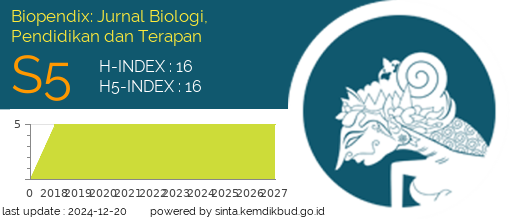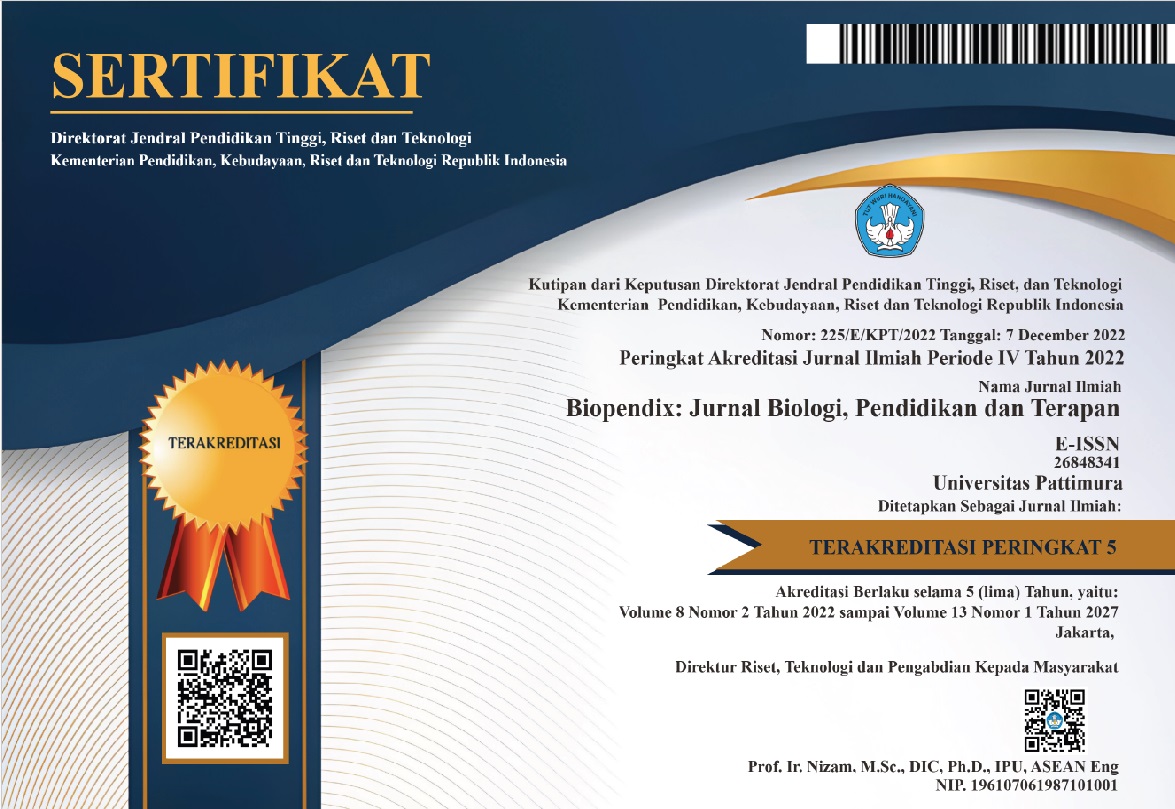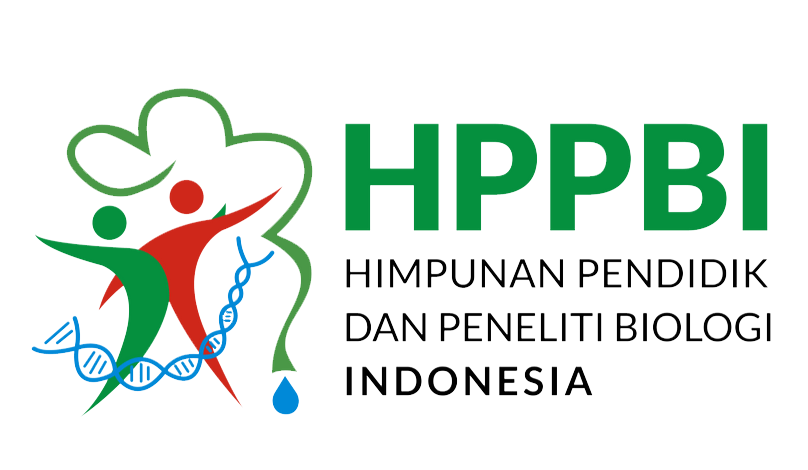KOMPOSISI ASAM LEMAK CACING LAUT SIASIA (Sipunculus, SP) DARI PERAIRAN PANTAI PULAU NUSALAUT
Abstract
Background: "Siasia" is a seaworm species in the phylum that includes Sipuncula Sipunculidea class. This animal has been consumed for generations by coastal communities Nusalaut Island, central mollucas but not yet universally known. Until now there has been obtained gisi complete composition. This study aimed to identify the composition of fatty acids contained in vain fresh seaworms.
Method: Seaworms vain taken from coastal waters of Negeri Titawaai and Nalahia Nusalaut Island, Central Moluccas in March 2014. The parameters analyzed include methods is sokhlet fat content and fatty acid by GC method.
Result: The results showed fresh siasia fat content 1.12% of coastal waters Titawaai while 1.91% of coastal waters Nalahia. Fatty acids seaworms were identified from coastal waters Titawai is kaparat acid (C10: 0), lauric acid (C12: 0), myristic acid (C14: 0), palmitoleic acid (C16: 1), stearic acid (C18 : 0), linolenic acid (C18: 3) acid and eicosapentaenoic (C20: 5) while the fatty acids of seaworm vain of coastal waters Nalahia include is lauric acid (C12: 0), myristic acid (C14: 0), palmitoleic acid ( C16: 1), stearic acid (C18: 0) and eicosapentaenoic acid (C20: 3).
Conclusion: Siasia fatty acid from Titawai waters of the identified seven seas of each capsic acid (C10: 0), lauric acid (C12: 0), myristic acid (C14: 0), palmitoleic acid (C16: 1) , Stearic acid (C18: 0), linolenic acid (C18: 3) and eicosapentaenoic acid (C20: 5) whereas Siasia fatty acids from Nalahia's coastal waters were identified as five lauric acid (C12: 0), myristic acid (C14: 0), palmitoleic acid (C16: 1), stearic acid (C18: 0) and eicosapentaenoic acid (C20: 3).
Downloads
References
AOAC Associaton of Official Analytical Chemist. 2005. Official Methods of Analysis of the Association of Official Analytical Chemist 18 th Edition. Gaithersburg, USA: AOAC International, Inc.
Cutler, E. B. 1994. The sipuncula: their systematic, biology and evolution. Cornell Univ. Press. Ithaca, N.Y. 453p.
Edison 2010. Komposisi asam lemak ikan Nila (Orechromus niloticus) dan Baung (Macrones nemurus) budidaya. Jurnal Pengolahan Hasil Perikanan Indonesia. 13(2): 96-104
Fakhrurrozi, Y. 2011. Studi Etnobiologi, Etnoteknologi Dan Pemanfaatan Kekuak (Xenosiphon sp.) Oleh Masyarakat Di Kepulauan Bangka-Belitung. Disertasi. Bogor: PPs. IPB. Hal 1-2-6.
Freije A M, Awadh M N. 2010. Fatty acid compositions of Turbo coronatus Gmelin 1791. British Food Journal 112(10): 1049-1062.
Guderley H, Comeau L, Tremblay R, Pernet F. 2007. Temperature adaptation in two bivalve species from diff erent thermal habitats: enegenics and remodeling of membrane lipid. Journal Experimental Biology 210(2): 2999-3014.
Imre S, Saghk S. 1997. Fatty acid composition and cholesterol content of mussel and shrimp consumed in Turkey. Journal Marine Sciences 3(3): 179-189.
Leblanc JC, Volatier JL, Aouachria NB, Oseredczuk M, Sirot V. 2008. Lipid and fatty acid composition of fish and seafood consumed in France. Journal of Food Composition and Analysis 21(5): 8-16.
Mardiana. 2011. Karakteristik asam lemak dan kolesterol rajungan (Portunus pelagicus) akibat proses pengukusan. [skripsi]. Bogor: Fakultas Perikanan dan Ilmu Kelautan, Institut Pertanian Bogor.
Mateos HT, Lewandowski PA, Su XQ. 2010. Seasonal variations of total lipid and fatty acid contents in muscle, gonad and digestive glands of farmed Jade Tiger hybrid abalone in Australia. Journal Food Chemistry 123(3): 436-441.
Ozogul Y dan Ozogul F. 2007. Fatty acid profiles of commercially important fish species from the mediterranean. Food Chem 100(4):1634-1638.
Pamungkas J. 2010. Sipuncula: Biota Laut yang Kontrovertif.Oseana 35 (1): 7-13.
Pradina, 1993. Catatan Kecil Tentang Sia-Sia, Cacing Laut Yang Dikonsumsi. LIPI. Ambon. Lonawarta 14 (1) : 47-51.
Silaban, B a. 2012. Profil Nutrisi Sipuncula (Cacing Kacang); Biota laut yang kontrovertif di Pulau Nusalaut, Maluku Tengah. Laporan hasil penelitian dosen pemula yang dibiayai dengan PNBP Lembaga Penelitian Universitas Pattimura.Ambon.
Silaban B b. 2012. Komposisi kimia dan pemanfaatan cacing laut “sia sia’’ yang dikonsumsi masyarakat Pulau Nusalaut Maluku Tengah Jurnal TRITON Jurusan Manajemen Sumberdaya Perairan Fakultas Perikanan dan Ilmu Kelautan Universitas Pattimura Ambon (2) 1-9
Silahooy V. 2008. Analisa komponen asam amino dan asam lemak dalam cacing laut jenis Sipunculus robustus. [skripsi]. Fakultas Matematika dan Ilmu Pengetahuan Alam, Universitas Pattimura. Ambon. Hal 1-79 (tidak dipublikasi).
Subhan R. 2014. Kandungan asam lemak dan kolesterol daging kerang simping (Amusium pleuronectes) segar dan rebus. [skripsi]. Bogor: Fakultas Perikanan dan Ilmu Kelautan, Institut Pertanian Bogor. Hal 1-30
Authors who publish with this Journal agree to the following terms:
- Author retain copyright and grant the journal right of first publication with the work simultaneously licensed under a creative commons attribution license that allow others to share the work within an acknowledgement of the work’s authorship and initial publication of this journal.
- Authors are able to enter into separate, additional contractual arrangement for the non-exclusive distribution of the journal’s published version of the work (e.g. acknowledgement of its initial publication in this journal).
- Authors are permitted and encouraged to post their work online (e.g. in institutional repositories or on their websites) prior to and during the submission process, as it can lead to productive exchanges, as well as earlier and greater citation of published works





 2
2






